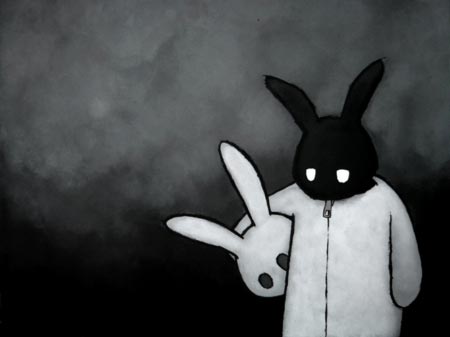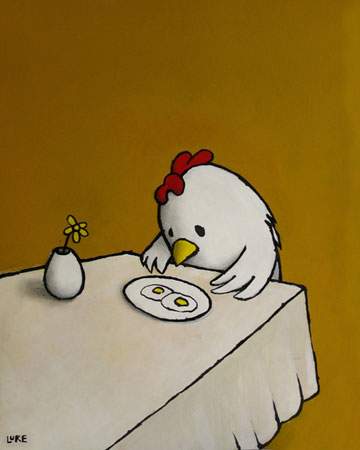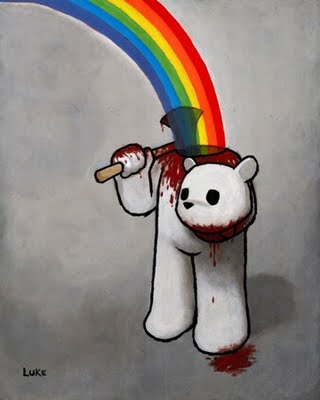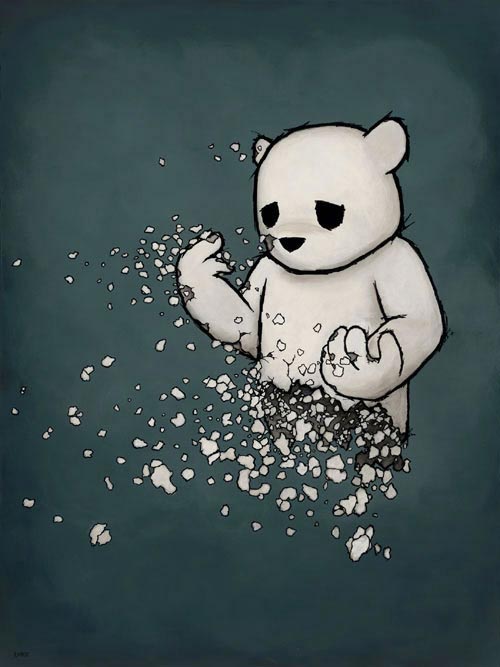Book Review: The Art of Luke Chueh: Bearing the Unbearable
Posted 8 years ago by Rob Lammle Art, Books

As a critic, I’m supposed to offer my unbiased opinion on a piece of media that I’ve been given. I’m supposed to set aside my own personal preferences and examine art – whether it be a cheesy 1980s TV series or an Oscar-winning modern classic – without letting my feelings interfere with my final verdict.
Well, I’m afraid I just can’t do that in this case.
Because, you see, I’ve been a fan of Luke Chueh’s artwork since my then-girlfriend-now-wife turned me on to it in 2005. She had seen his paintings online and instantly fell in love with them. I had a similar experience when she showed me his website, and I saw for the first time his unique style, motifs, and message.
Chueh’s art is almost always described using the same adjectives and phrases – “cute, but dark”, “adorable, but sad”, “funny, but deep” – and even though these have become cliché at this point, that doesn’t mean they aren’t true. Much of Chueh’s work features animals that look like costumed out-of-work actors on their way to a kid’s backyard birthday party, ready to snap a photo with a group of seven year-olds because it’s the only gig they can get.

In fact, this idea of costumes, masks, facades, is a big part of what drives his work. Many of his pieces take this literally by showing the true nature of the person inside the suit when the over-sized head is removed. When the white rabbit head is removed, we see the black rabbit inside. When the bear costume head is removed, we see a real Grizzly underneath. When the Grizzly head is removed, we see the Gummy Bear head. We all, every day, put on a mask in order to hide who we really are. Chueh’s work makes that lie a little easier to digest because it’s so often presented in an adorable manner.
When subjects aren’t revealing themselves to the world, instead Chueh reveals himself through them. Rabbits lop off their own ears with scissors. A bear eats his arm laid out Sashmi style. The left hand of another bear is shown disproportionately large and covered in blood. A chicken eats two eggs sunny side up. This mix of cute characters doing horrific things is a staple of Chueh’s work. Sometimes it’s done for comedic affect – like the chicken and the eggs – but more often than not these are clearly expressions of Chueh’s own self-loathing, self-doubt, and desire for self-destruction. He lays himself bare for us to see his feelings, but more often than not, we recognize these same feelings within ourselves. It’s not unusual to look at a Chueh painting and laugh at first. But then, only a few moments later, realize how sad you are, and you may not even really know why.

This is the first collection of Chueh’s artwork, and as art books go, this is a model that should be followed more often. In most coffee table art books, there are usually only a few full-page images of the artist’s work at the beginning of a chapter, while the rest of the book is filled with smaller reproductions that are so tiny you can’t really make out any kind of detail. There are instances where Chueh’s work has been reduced to a quarter of the page, but there are many more pages where the art takes up at least half, if not the entire page. This approach really helps you see the artwork, which is the whole point of a coffee table art book in the first place.
The accompanying text for the images is fairly typical stuff for an art collection. Chueh tells us his feelings about a piece or a show, which is a nice look into his thought process. The rest of the quotes are from friends espousing either Chueh’s genius with a paintbrush or his loveable personality. Neither is bad, but neither delves too deeply into who Chueh is, either. You could say the artwork should speak for itself, that it’s more powerful without any kind of personal context, and that argument is definitely valid. But as someone who is interested in the human story behind the art, the text leaves me wanting more. I guess I’ll just have to wait for the eventual biography someday.

Fan of Luke Chueh’s work will really appreciate this book. It’s so nice to have large, high-quality reproductions right in front of you. It gives you a glimpse at his technique, but more importantly, the message being conveyed by his work just slaps you in the face at this scale. If you can’t own a Chueh original (and most of us probably can’t at the prices his work demands today), this is a worthy substitute.

The Art of Luke Chueh: Bearing the Unbearable will be available June 12, 2012 from Amazon.com, Barnes & Noble, or other fine retailers.
